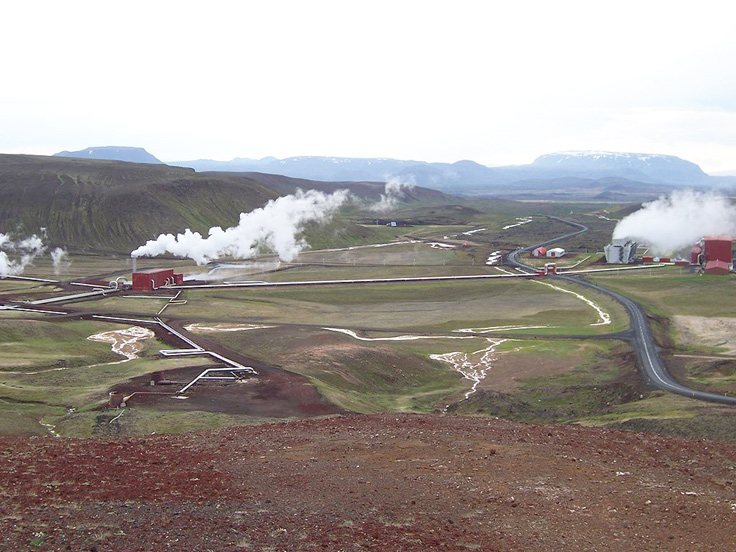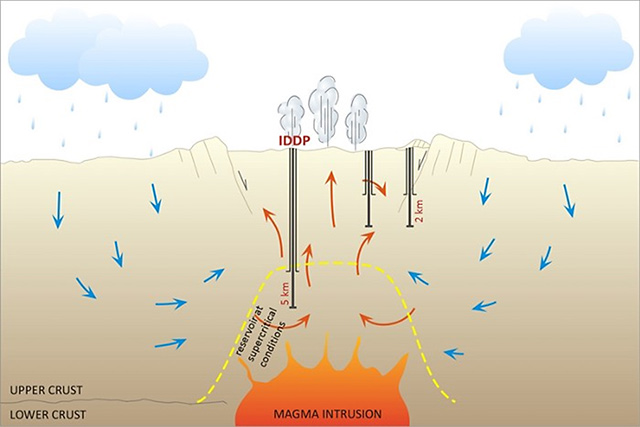
Deep within our planet, intense heat left over from Earth’s formation is stoked by the continued decay of radioactive isotopes.
In a few places, like Iceland, geologic features allow this heat to come close to the surface. Here, it often turns groundwater to steam.
For a century, Iceland has been tapping into this naturally occurring steam and using it to heat the homes, streets and sidewalks of Reykjavik. Or to run power plants to make electricity.
Now, Iceland is trying to take it a step further. Scientists are drilling experimental wells, nearly 3 miles into the earth, to try to tap into superheated water.
At what’s called supercritical temperatures, above 750 degrees Fahrenheit, water and steam merge into a single supercritical fluid, which behaves differently than either.
A typical Icelandic geothermal steam well produces the equivalent of 5 megawatts of energy. A supercritical well could produce 10 times that.
This means that just three or four wells could heat an entire city.
Of course, this is a very challenging prospect. At such high temperatures and pressures, supercritical fluid is very hard to handle.
Iceland shut in its first successful well after a valve failure.
But the massive amount of energy on tap could make this a promising energy source—in those rare, lucky places where supercritical water is near enough to the surface to access.
Background
Synopsis: Earth’s natural heat is the source of geothermal energy, and it is most accessible where melted rock comes close to the surface near volcanoes. With 30 active volcanic systems, Iceland is known as “the land of fire and ice” and has pioneered the use of geothermal energy for more than a century. Recent experiments are taking that leadership a step further with deep drilling to reach supercritical geothermal reservoirs that may produce 10 times the power of traditional geothermal wells.

- Geothermal energy is the natural heat left over from the formation of Earth and the constant decay of radioactive isotopes.
- The deeper you go below Earth’s surface, the hotter it gets; the core is a blistering 7600oF (4200oC). At the same time, pressures increase dramatically.
- In certain places, tectonic forces bring Earth’s deep heat closer to the surface. This is most common along plate boundaries but may also occur in the middle of plates in some special cases like the Hawaiian Islands and Yellowstone.
- Volcanic systems develop where deep heat approaches Earth’s surface, with magma chambers of molten rock. As hot magma rises through denser rock, it may erupt quiescently or explosively depending on its chemistry.
- When water interacts with hot rock, steam and hot water are produced that can be used as a direct heat source or to turn turbines for electricity generation. This is known as geothermal power.
- Iceland is called “the land of fire and ice” because it has more than 30 active volcanic systems, with eruptions occurring every two to four years.
- Iceland is located along the Mid-Atlantic Ridge plate boundary and is one of the most geologically active places on Earth.
- In 2010, the Eyjafjallajökull Volcano erupted, causing six days of chaos as air travel for about 10 million travelers was disrupted over 20 countries around northern and western Europe.
- Today, about 85% of Icelandic homes are heated with direct geothermal energy piped from “low” temperature geothermal fields with water temperatures below 300oF (150oC).
- Geothermal waters heat streets and sidewalks in Reykjavik in winter.
- The first use of geothermal energy in Iceland occurred in 1907.
- Iceland’s electricity is 100% renewable.
- About 75% comes from Iceland’s abundant glacial meltwater-sourced hydropower.
- The remaining 25% comes from geothermal power plants.
- Traditional geothermal power plants generate electricity in several ways:
- Some geothermal reservoirs produce “dry” steam that spins turbines directly.
- Binary cycle plants use lower-temperature geothermal water to heat fluids that boil at lower temperatures than water, like isobutene, making steam that turns turbines.
- Flash steam plants use wells that produce water at temperatures greater than 300-700oF (150-370oC). Some of the water turns to steam as it reaches lower pressures at the surface and spins turbines. Once it condenses, the water is pumped back down to the geothermal reservoir.
- In 2000, some innovative scientists from industry and the National Energy Authority of Iceland had a big idea: How would drilling into “supercritical” geothermal fluids change the power generation game?
- They launched the Iceland Deep Drilling Project (IDDP) to find out.
- Supercritical fluids occur at temperatures and pressures high enough that distinct gas and liquid phases don’t exist.
- As temperatures and pressures increase progressively beneath Icelandic geothermal fields, water gets lighter and lighter and steam gets heavier and heavier until they merge into a single supercritical phase above 705oF (374oC) and 221 bars of pressure.
- Supercritical water is a different beast. At 752oF (400oC), it contains five times the energy of water at 392oF (200oC), it transfers energy twice as efficiently, and it flows out of the ground with a lower viscosity than water.
- Typical geothermal wells in Iceland are drilled to about 8,200 ft (2.5 km) and can produce about 5 Megawatts electric (MWe) of electricity from water at 575oF (300oC). A feasibility study in 2003 showed that with a similar inflow rate of steam, a well to supercritical reservoirs at about 16,400 ft (5 km) would access fluids at 842-1112oF (450-600oC) and pressures of 230-260 bars, yielding a 10-fold increase in power output—about 50 MWe.
- This could mean that instead of 30-35 wells, a city the size of Reykjavik (about 217,000 people) could be powered by only three to four wells drilled twice as deep—considerably decreasing the environmental impact on the surface, as well as the overall cost.
- The consortium began drilling the IDDP-1 well in 2009 near the Krafla Volcano in northern Iceland, with a plan to drill to about 13,000 ft (4 km) where they expected to find supercritical water.
- However, about halfway to their target, at just 6,900 ft (2.1 km), they got a big surprise: They drilled into a magma chamber, filled with molten rhyolite at 1650oF (900oC).
- It was too shallow to attain supercritical pressures, but when tested, it produced at a rate sufficient to generate 35 MWe.
- It was never connected to the power grid and was eventually shut in after a master valve failure.
- The IDDP-2 well was drilled by deepening an existing 8,200-ft (2.5-km)-deep well in the Reykjanes geothermal field in far southwestern Iceland.
- In January 2017, it reached a depth of 15,285 ft (4.659 km), finding supercritical fluids at about 800oF (427oC) and 340 bars.
- Two years later, scientists continue to evaluate well data with some of their original questions in mind:
- Can fluid be injected below the geothermal field to produce power?
- What happens at the base of the reservoir?
- How are the saline waters circulated and heated?
- Can we learn anything relevant to the study of natural seafloor hydrothermal vents like those along the East Pacific Rise?
- Results are due out sometime in 2019-2020.
- Understanding what kind of power output might be realized by supercritical geothermal energy exploitation is a step change for a type of renewable energy that is available in some areas of the world day and night, rain or shine.

